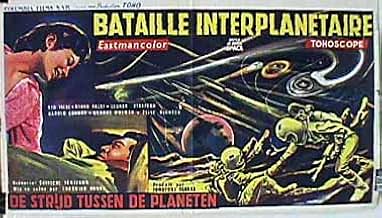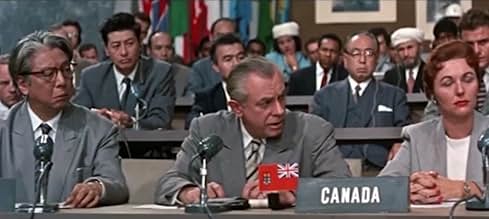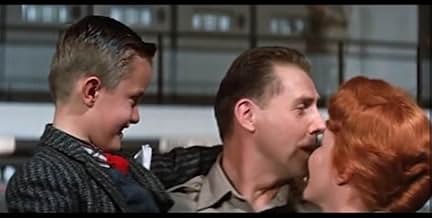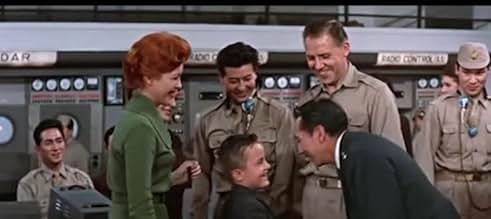IMDb-BEWERTUNG
5,6/10
1729
IHRE BEWERTUNG
Füge eine Handlung in deiner Sprache hinzuThe nations of the Earth unite in a common cause to fight off an invader from outer space.The nations of the Earth unite in a common cause to fight off an invader from outer space.The nations of the Earth unite in a common cause to fight off an invader from outer space.
- Regie
- Drehbuch
- Hauptbesetzung
- Auszeichnungen
- 1 Nominierung insgesamt
Ryô Ikebe
- Maj. Ichiro Katsumiya
- (as Ryo Ikebe)
Kyôko Anzai
- Etsuko Shiraishi
- (as Kyoko Anzai)
Harold Conway
- Dr. Immerman
- (as Harorudo Konwei)
Elise Richter
- Sylvia
- (as Erisu Rikutâ)
Hisaya Itô
- Kogure
- (as Hisaya Ito)
Nadao Kirino
- Gravity Man
- (as Hiro-o Kirino)
Kôzô Nomura
- Rocket Commander
- (as Kozo Nomura)
Takuzô Kumagai
- Alien
- (as Jirô Kumagai)
Katsumi Tezuka
- Alien
- (as Katsumx Tesuka)
Mitsuo Tsuda
- Air General
- (as Mitsuo Isuda)
- …
Osman Yusuf
- Bystander
- (as Osuman Yusefu)
Empfohlene Bewertungen
Pint-size aliens from the planet Natal are bent on conquering the Earth in this colorful space opera from the heyday of Toho Studios. Second in a trilogy of space-themed movies directed by the inimitable Ishiro Honda (the other two being "The Mysterians" and "Gorath") this is pure mindless fun.
The special effects may seem dated now, but for the time they were first-rate, much better than your average sci-fi and far superior to any of the monster films Toho cranked out from the mid-60s onward. This was definitely not done on the cheap: The sets are well thought-out, the astronomical backgrounds detailed and quite convincing.
Eiji Tsuburaya's intricate miniature work is amazing as always. The voyage to the Moon, the fight on the lunar surface, and the final showdown (with souped-up X-15s squaring off against alien saucers and a huge mother ship) are elaborately staged and exciting.
Which is why it's easy to forgive the occasional cheesy bits. For instance, when the beautiful SPIP rockets are taking off for the Moon, Honda illustrates the effects of high-G by having one of the crewmen put his hands on either side of his face and *pull* the flesh back. I also suspect they were running out of funds (the film's only 74 minutes long) when it came time to shoot the scene where the alien mother ship tears up downtown Tokyo with a gravity-reversing ray. Although it's a clever effect, apparently achieved by building the models on top of compressed air jets, the sequence feels too short. Plus the miniatures just don't look quite as detailed or realistic, when compared to other Toho films of the era.
My biggest complaint: In the one scene where you actually meet the aliens in the flesh (sort of) they're in spacesuits which make them look like midget Michelin Men and they sound like a bunch of squeaky dog toys. When a crowd of them "menaces" the heroine, there's not a ray gun in the bunch; all they can can do is shuffle, wave their arms and squeak. Not very intimidating, to say the least. (If anything, they're hilariously reminiscent of that roomful of sex-crazed Cub Scouts in Woody Allen's "Everything You Always Wanted To Know About Sex".)
But the good far outweighs the not-so-good in this romp. In a theater, in its original Tohoscope (Toho Studios' equivalent of Cinemascope), it must have been something to see.
(Update: In 2007, an outfit called Monsters in Motion released "Uchu Daisenso" on DVD -- in letterbox, in the original Japanese with English subtitles -- as part of their "Toho Masters" series. With its companion piece "Gorath" available from MiM, and Tokyo Shock's gorgeous edition of "The Mysterians", Honda's entire space trilogy is now obtainable in the original, unedited widescreen versions.)
The special effects may seem dated now, but for the time they were first-rate, much better than your average sci-fi and far superior to any of the monster films Toho cranked out from the mid-60s onward. This was definitely not done on the cheap: The sets are well thought-out, the astronomical backgrounds detailed and quite convincing.
Eiji Tsuburaya's intricate miniature work is amazing as always. The voyage to the Moon, the fight on the lunar surface, and the final showdown (with souped-up X-15s squaring off against alien saucers and a huge mother ship) are elaborately staged and exciting.
Which is why it's easy to forgive the occasional cheesy bits. For instance, when the beautiful SPIP rockets are taking off for the Moon, Honda illustrates the effects of high-G by having one of the crewmen put his hands on either side of his face and *pull* the flesh back. I also suspect they were running out of funds (the film's only 74 minutes long) when it came time to shoot the scene where the alien mother ship tears up downtown Tokyo with a gravity-reversing ray. Although it's a clever effect, apparently achieved by building the models on top of compressed air jets, the sequence feels too short. Plus the miniatures just don't look quite as detailed or realistic, when compared to other Toho films of the era.
My biggest complaint: In the one scene where you actually meet the aliens in the flesh (sort of) they're in spacesuits which make them look like midget Michelin Men and they sound like a bunch of squeaky dog toys. When a crowd of them "menaces" the heroine, there's not a ray gun in the bunch; all they can can do is shuffle, wave their arms and squeak. Not very intimidating, to say the least. (If anything, they're hilariously reminiscent of that roomful of sex-crazed Cub Scouts in Woody Allen's "Everything You Always Wanted To Know About Sex".)
But the good far outweighs the not-so-good in this romp. In a theater, in its original Tohoscope (Toho Studios' equivalent of Cinemascope), it must have been something to see.
(Update: In 2007, an outfit called Monsters in Motion released "Uchu Daisenso" on DVD -- in letterbox, in the original Japanese with English subtitles -- as part of their "Toho Masters" series. With its companion piece "Gorath" available from MiM, and Tokyo Shock's gorgeous edition of "The Mysterians", Honda's entire space trilogy is now obtainable in the original, unedited widescreen versions.)
Saw this when I was 11 years old, I recall the rocket fighters sent up by the Earth Forces are based on the X-15 rocket plane. One thing I remember-and it moved me at the time, and is one of the movie's strengths-is the scene where the earth space ships go past the area where the space station was destroyed-and you see the bodies of the crew. The action moves at a brisk pace, no long winded speeches or philosophizing. The SFX are pretty good for the time. As a side issue, I got a chuckle when I saw "Star Wars" in 1977, I recognized the "futuristic weapons" as being models of British Lee Enfields, German MG-42 machine guns, Heckler & Koch submachine guns.
I saw this film in 1960 playing with "The Time Machine" as a double feature. Though not as rich in story line as "The Mysterians" this film really takes off when the two Speep earthships go to the moon to battle a base set up by the planet Matal who also fly "Mysterian" style flying saucers. On the moon the action really starts with marvelous raygun battles between the enemy and earth forces. The earth forces possess a marvelous heat ray cannon as well as smaller but potent raygun rifles. Later in the film, the earth forces battle invading flying saucers and a mother ship with X-15 styled fighter craft equipped with heat ray guns. The finale with the mother ship's ray gun destroying Toyko is done quite well.
For the time this film was made, the special effects are quite good. Considering my nickname is ray-gun 3, this is a ten star IMDb vote scale film in that department. I think the best scene in the film is on the moon where one of the crew stays behind with his ray rifle destroying flying saucers so the earth force can get away in their Speep spaceship. This scene is one of the best piece of special effects I have scene in this type of movie. A thought to remember is the film was made 17 to 18 years before "Star Wars". An outstanding accomplishment by Toho studios.
For the time this film was made, the special effects are quite good. Considering my nickname is ray-gun 3, this is a ten star IMDb vote scale film in that department. I think the best scene in the film is on the moon where one of the crew stays behind with his ray rifle destroying flying saucers so the earth force can get away in their Speep spaceship. This scene is one of the best piece of special effects I have scene in this type of movie. A thought to remember is the film was made 17 to 18 years before "Star Wars". An outstanding accomplishment by Toho studios.
Aliens are causing havok on Earth. So a bunch of astronauts are sent to the moon to war with these little funny midget aliens. Just a big battle from beginning to end, with the aliens sucking up Tokyo at the end (man is that cool). It is basically like a Japanese Independence Day except not nearly as intense or violent
Ishiro Honda is the Steven Spielberg of Japan in that he created a huge body of work...big, exciting, fantasy movies of such number, quality and iconic value that he stands head and shoulders above his peers.
This film is among Honda's lesser known works, and is a rarity in that there is absolutely no Kaiju in this film, not even a robot Kaiju such as seen in the better-known 'The Mysterians'. And, in terms of the fantastic cinema of Japan, this is one of the more serious science fiction creations of the period, although containing many inaccuracies that would be glaring to anyone with the slightest familiarity to the work of George Pal.
This film features creative and interesting FX that vastly outshine most of what the US was producing at this time, and might even have the most complex miniature sets and sequences of anything produced by Toho during the classic period. There are large scale space ship dogfight sequences that anticipate Star Wars, which was done 17 years later.
The plot, while not profound, is sufficiently interesting and entertaining and the actors are good enough to make this an enjoyable escapist film. Thematically, this is classic Invasion Literature, with few new wrinkles thrown in...definitely straightforward, Honda doesn't give us anything ambiguous or subversive to chew over.
Any fan of old-school scifi and Kaiju films is liable to enjoy this one very much, it's just an impressive spectacle.
This film is among Honda's lesser known works, and is a rarity in that there is absolutely no Kaiju in this film, not even a robot Kaiju such as seen in the better-known 'The Mysterians'. And, in terms of the fantastic cinema of Japan, this is one of the more serious science fiction creations of the period, although containing many inaccuracies that would be glaring to anyone with the slightest familiarity to the work of George Pal.
This film features creative and interesting FX that vastly outshine most of what the US was producing at this time, and might even have the most complex miniature sets and sequences of anything produced by Toho during the classic period. There are large scale space ship dogfight sequences that anticipate Star Wars, which was done 17 years later.
The plot, while not profound, is sufficiently interesting and entertaining and the actors are good enough to make this an enjoyable escapist film. Thematically, this is classic Invasion Literature, with few new wrinkles thrown in...definitely straightforward, Honda doesn't give us anything ambiguous or subversive to chew over.
Any fan of old-school scifi and Kaiju films is liable to enjoy this one very much, it's just an impressive spectacle.
Wusstest du schon
- WissenswertesThis film was the first Japanese science fiction film which had the original Japanese cast and crew listed on the posters and other advertising material in the United States.
- PatzerThe funniest bits are the gravity antics. When the first scout ship turns off the thrusters and the crew all unfastens their safety belts, one of them flies up to the ceiling. He is so surprised, clearly no-one told this astronaut that there was no gravity in the spacecraft. They help him down and the chief tells him that there is no gravity in the ship. Then they all begin walking around completely normally.
- Alternative VersionenThe final 16mm prints struck for U.S. television distribution had the final third of the film letterboxed for the widescreen Tohoscope format.
- VerbindungenFeatured in Aweful Movies with Deadly Earnest: Battle in Outer Space (1966)
- SoundtracksBurlesque-style Rondo
Composed by Akira Ifukube
Top-Auswahl
Melde dich zum Bewerten an und greife auf die Watchlist für personalisierte Empfehlungen zu.
- How long is Battle in Outer Space?Powered by Alexa
Details
- Laufzeit
- 1 Std. 30 Min.(90 min)
- Sound-Mix
- Seitenverhältnis
- 2.35 : 1
Zu dieser Seite beitragen
Bearbeitung vorschlagen oder fehlenden Inhalt hinzufügen

























